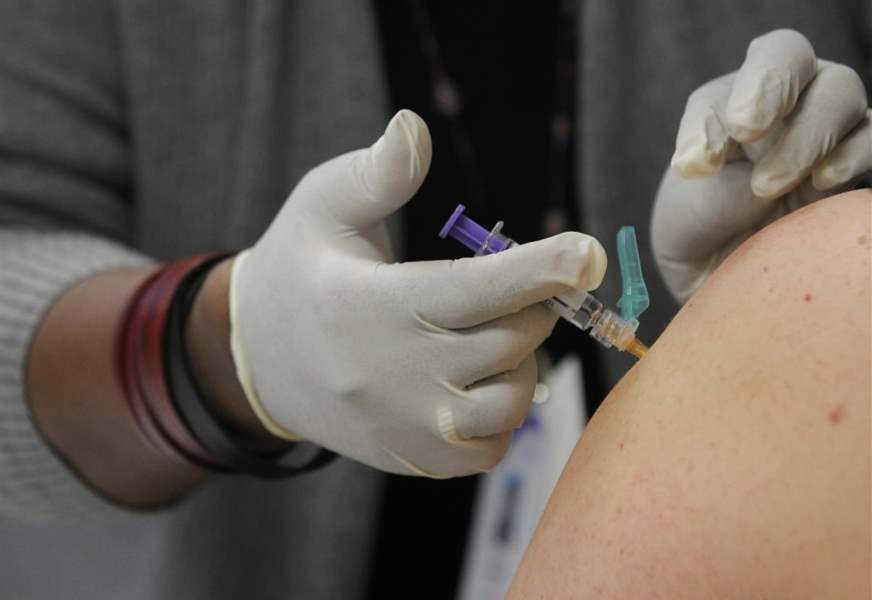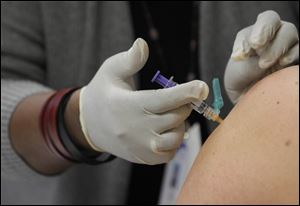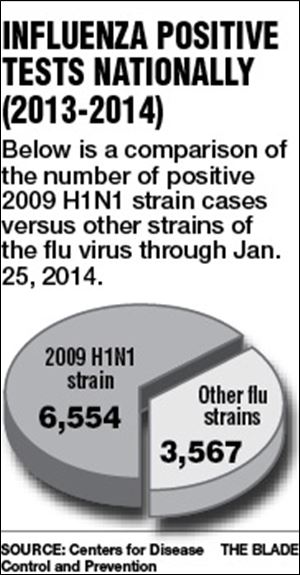
Flu season hits hard in Toledo area, but it’s worse elsewhere
490 hospitalized in Cuyahoga County
2/2/2014
Nationally, H1N1 is striking the 18 to 64-year-old group particularly hard this year, and only 31 percent of 18 to 49-year-old people had gotten a flu shot.
THE BLADE
Buy This Image

Nationally, H1N1 is striking the 18 to 64-year-old group particularly hard this year, and only 31 percent of 18 to 49-year-old people had gotten a flu shot.
February is traditionally one of the most active flu months in Ohio and Michigan, but Lucas County already has experienced a harsh flu season this fall and winter compared with recent years.
Toledo-Lucas County Health Commissioner David Grossman said it’s difficult to know if the flu season has peaked.
“I don’t think anybody can say definitively where we are at but we haven’t had any more deaths and the number of hospitalizations has slowed down. I would like to think we have reached the zenith and that it is leveling off but it could pick up again like crazy next week,” Dr. Grossman said.
More than 85 people have been hospitalized since Nov. 11, and the H1N1 strain of the virus has re-emerged despite being included in the influenza vaccine this year. The number of hospitalizations is much higher than in previous years. Last year, there were 63 flu hospitalizations in Lucas County by Jan. 17; two years ago there were only 14.
There have also been four flu-related deaths in Lucas County and eight total in northwest Ohio and southeast Michigan.
“We have to keep this in perspective. We know some people are going to die of the flu every year. It’s always more gratefulness and luck that they didn’t. To be honest, in Ohio and in Lucas County we’ve been relatively fortunate in the severity of the flu outbreaks the past couple years,” Dr. Grossman said.
During the past two years, there were no confirmed deaths from the flu in Lucas County. There was one flu-related death in the 2010-2011 flu season, and in 2009-2010, the year of the H1N1 pandemic, there were four deaths.

Grossman
Around Ohio
Despite the flurry of flu activity, Lucas County has still fared better than many other communities across the state and the nation so far this year.
The Ohio Health Department collects information on the number of flu hospitalizations in each county.
The most recently published report shows that Cuyahoga County, home of Cleveland and the most populous county in the state, had posted more than 490 flu-related hospitalizations as of Jan. 25.
There have been nine flu-related deaths in Cuyahoga County, and eight of those deaths occurred over the past three weeks, said Richard Stacklin, researcher for the Cuyahoga County Board of Health.
“The data is suggesting that hospitalizations and flu-like illness appear to have peaked during the end of December but there could be another spike during the traditional peak time from mid-February to mid-March,” Mr. Stacklin said.
Stark County, the home Canton, which is smaller than Lucas County, has seen 115 flu-related hospitalizations this year.
In fact, the only large Ohio county with fewer flu-related hospitalizations than Lucas is Mahoning County, where Youngstown in located, with just 35 flu-related hospitalizations.
“One thing about the flu is that it is unpredictable,” said Nick Fisher, the influenza surveillance epidemiologist for the Ohio Health Department.
“The flu has such a short incubation period you can have peaks sporadically,” he said.
According to Mr. Fisher, the week of Jan. 5 through 12 saw the highest level of hospitalizations so far this season with 402 across the state, but hospitalizations have been trending downward in the last two weeks, he said.
The Ohio Department of Health, which does not track adult flu-related deaths, reports that no children have died this season.
Up north
“In Michigan we tend to peak in January and February and in general ER visits and hospitalizations have slowed. We still anticipate the flu season is potentially peaking so it’s still important for people to get their flu vaccine,” said Angela Minicuci, spokesman for the Michigan Department of Community Health.
Hospitals are not required to report adult deaths or the number of flu-related hospitalizations in Michigan, so the health department has what it calls a surveillance network which includes a few hospitals from each region in the state, Ms. Minicuci said.
So far that group has reported 345 flu-related hospitalizations in Michigan with 81 of those occurring in the last two weeks, she said.
She also said one child has died in Michigan from the flu this season.

National view
The Centers for Disease Control and Prevention tracks flu activity nationally, and according to its most recent report flu activity was still widespread across the country based on information supplied through Jan. 17.
The CDC divides the country into regions to monitor how the flu is spreading, and both Ohio and Michigan are in Region 5, along with other Midwestern states including Indiana, Illinois, Wisconsin, and Minnesota.
According to the CDC, flu activity in Region 5 is still considered high as some 40 percent of those who visited a doctor with symptoms tested positive for flu.
What's even more concerning for health officials is that the 2009 strain of the H1N1 virus has been the most common flu identified this season, said Jason McDonald, spokesman for the CDC.
The H1N1 flu virus caused a worldwide pandemic in 2009. Also called the swine flu, it affected millions of U.S. residents and spread quickly, causing confusion and panic around the world.
Any flu infection carries a risk of serious complications, hospitalization, or death, but the H1N1 strain caused particular concern because of the number of children and young adults who were affected.
Since then, H1N1 has been incorporated into the flu vaccine every year. This season’s flu vaccine contains protection against influenza A (H1N1) virus, influenza A (H3N2) virus, and one or two influenza B viruses, according to the CDC.
Nationally, 63 percent of all influenza cases reported through Jan. 18 are the H1N1 strain of the virus, said Mr. McDonald.
H1N1 is striking the 18 to 64-year-old group particularly hard this year, and only 31 percent of 18 to 49-year-old people had gotten a flu shot, Mr. McDonald said.

Vaccinations
Ms. Minicuci said the number of younger adults getting vaccinated is even lower in Michigan — only 11 percent. This is the reason that H1N1 is so prevalent in that age group. “We are seeing a lot of young college-age adults with H1N1 being hospitalized and dying of the flu this season,” Ms. Minicuci said.
Across the state of Ohio, large numbers of those hospitalized this year were in the 40 to 59-year-old age group. In Cuyahoga County that group accounted for more than half of the flu-related hospitalizations and about 40 percent of the hospitalizations here in Toledo.
Health officials note that typically it is young children or people over the age of 65 who tend to end up in the hospital because of the flu.
“H1N1 has been a part of the flu vaccine ever since 2009, in addition to some other types, but influenza viruses have their own ability to mix and create different characteristics and that appears to be what’s going on. We don’t know why it’s doing it this year. We know it is.
“We also know that we have the best vaccine we could for this but it’s not gonna be 100 percent effective,” Dr. Grossman said.
A review of records from the Toledo-Lucas County Health Department showed that 14 out of 65 flu hospitalizations reported locally were confirmed cases of the H1N1 virus this year.
The Toledo-Lucas County Health Department has revised some information released last month about the identity of one of the flu victims this year. Dr. Grossman previously said a 70-year-old resident died on Jan. 10, but the department said this week that information was incorrect. It was a 53-year-old man who died at Mercy St. Vincent Medical Center on Jan. 8.
“In regards to the age concerns of recent flu deaths, especially the 70-year-old, this brings to the forefront what I have been saying all along. Until we receive confirmation in written form, the situation is very fluid. It appears that somehow the age was misread or given wrongly,” Dr. Grossman said.
Hospitals are required by law to supply information about the number of patients being treated for the flu to the Toledo-Lucas County Health Department, but that regulation does not apply to deaths.
Hospitals do not report the adult flu-related deaths directly to Dr. Grossman. Instead, he must wait days or weeks to receive the official death certificate from the physician of record before he can release information to the public.
Contact Marlene Harris-Taylor Marlene Harris-Taylor at: mtaylor@theblade.com or 419-724-6091.